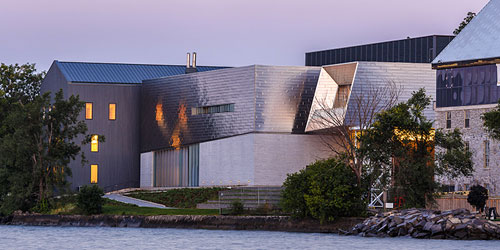Queen’s University's New Concert Hall: The Isabel by Marc-Olivier Laramée
/ November 1, 2014
Version française...
Flash version here.

Little by little, Canada’s major musical institutions are renewing their facilities. After the Royal Conservatory’s Koerner Hall in Toronto and Montreal’s Maison symphonique, Queens University in Kingston, Ontario, is doing likewise. Many people will recognize similarities between The Isabel Bader Centre for the Performing Arts (The Isabel) and Montreal’s new concert hall, since the same acoustic design firm, Artec (now integrated with the firm Arup), designed the project. Other collaborators included Snøhetta and N45 Architecture as well as Theatre Projects Consultants.
Queen's University wanted a multifunctional space that would serve not only music students, but also those in film, media studies, theatre and fine arts. Therefore, the centre juggles many different performance and teaching functions. It includes a concert hall, a studio theatre, a film screening room, a multipurpose rehearsal room, and a production studio as well as teaching spaces for various departments.
The project’s success was possible thanks to a remarkable contribution of $31 million from Alfred and Isabel Bader. Alfred Bader is a Queens University alumnus, having obtained two bachelor’s degrees in chemistry and history as well as a master’s degree in chemistry. The Baders are long-time philanthropists and the backers of several scholarships at Queens. The family also manages an art gallery made up of their own private collection. The new hall, at a total cost of $72 million, was named in honour of Mrs. Bader.
The Arrival
The first things a visitor to The Isabel sees are its modern architecture, and its subtle marriage with the historic parts of the building. The historic nature of the original stone buildings, which in the past served several purposes, including a brewery and stables, could not be altered. The architects therefore seamlessly incorporated the old stone buildings into the glass and stainless steel of the new one. The hall is a work of art in itself. The acoustics in the concert hall are almost perfect.
From the hall’s foyer, visitors have a breathtaking view of Lake Ontario. The exterior layout, including the back patio, has also been gorgeously done, creating the effect of land jutting into the water.
The Hall
The hall seats 566 and is ideal for recitals, small ensembles, orchestras, or choirs. An all-wood interior means exquisite acoustics.
“We wanted to create a hall where each member of the audience feels like they’re sitting next to the musicians on stage,” says Joe Solway, an acoustician from Arup. A listener would be pleasantly surprised to hear the sound of the piano, for example, as if they were attending a private concert.
On each side of the parterre, two sections of boxes run along the whole length of the hall. A balcony as well as a section of seats facing the conductor can serve as extra space for large choirs.
For many neophytes of modern acoustics, the placement of each wooden insertion seems random, creating an “aged antique” look. But everything is calculated to the millimetre. The Arup team has a sound laboratory at its New York offices and software that allows it to recreate the exact acoustics using a model of the room. In this way, each sonic and architectural detail has been thought out.
“Each of our decisions should preserve the essence of the project: a hall of international calibre,” says Takeshi Tornier, the person responsible for the project at Snøhetta.
The hall is equipped with variable acoustics thanks to an integrated system of wall curtains that can be deployed. They can thus accommodate classical music, jazz, rock, and pop, as well as film projections, as planned during construction.
The Acoustics
The hall’s acoustics are perfect for a piano recital, especially French repertoire. Bass notes sound especially good, with perfectly perceptible harmonies. The hall is completely soundproof, even with regards to lighting and ventilation; in fact, the acoustics are so good that you can hear the hammers of the piano striking the strings —which can be a bit distracting.
The hall is ideal for chamber music ensembles, neither too large nor too small. The advantage of the acoustics is that it is possible to hear each musician individually. The resulting sound could be compared to what a sound engineer might hear in the studio. One important feature of the centre is its rehearsal hall, which was acoustically designed to match the performance hall exactly. In rehearsal, musicians can hear exactly what will be heard in performance and thus avoid any surprises.
The combination of strings and piano fits well with the hall. However, an instrument like the piano seems to easily overpower a string ensemble. It’s therefore necessary to pay attention to the sonic equilibrium.
The Isabel is without a doubt an acoustic gem, where chamber music and vocal music will both be at their best. It remains to be seen whether jazz, pop, or rock will fare equally well. One thing is for sure: The Isabel will henceforth be a splendid jewel of the city of Kingston.
www.theisabel.ca
Translation: Rebecca Anne Clark
Version française... | 
